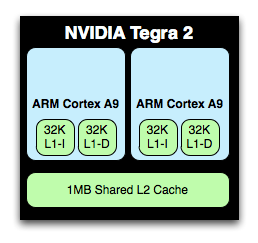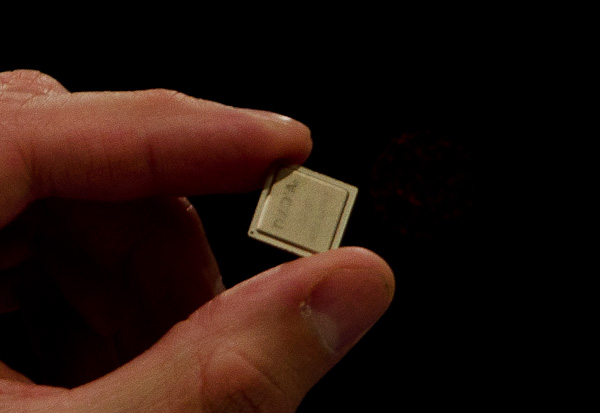NVIDIA's Project Kal-El: Quad-Core A9s Coming to Smartphones/Tablets This Year
by Anand Lal Shimpi on February 15, 2011 9:05 PM ESTThe Architecture
Kal-El looks a lot like NVIDIA's Tegra 2, just with more cores and some pin pointed redesigns. The architecture will first ship in a quad-core, 40nm version. These aren't NVIDIA designed CPU cores, but rather four ARM Cortex A9s running at some presently unannounced clock speed. I asked NVIDIA if both the tablet and smartphone versions of Kal-El will feature four cores. The plan is for that to be the case, at least initially. NVIDIA expects high end smartphones manufacturers to want to integrate four cores this year and going in to 2012.

The CPU cores themselves have changed a little bit. Today NVIDIA's Tegra 2 features two Cortex A9s behind a shared 1MB L2 cache. Kal-El will use four Cortex A9s behind the same shared 1MB L2 cache.
NVIDIA also chose not to implement ARM's Media Processing Engine (MPE) with NEON support in Tegra 2. It has since added in MPE to each of the cores in Kal-El. You may remember that MPE/NEON support is one of the primary differences between TI's OMAP 4 and NVIDIA's Tegra 2. As of Kal-El, it's no longer a difference.

Surprisingly enough, the memory controller is still a single 32-bit wide LPDDR2 controller. NVIDIA believes that even a pair of Cortex A9s can not fully saturate a single 32-bit LPDDR2 channel and anything wider is a waste of power at this point. NVIDIA also said that effective/usable memory bandwidth will nearly double with Kal-El vs. Tegra 2. Some of this doubling in bandwidth will come from faster LPDDR2 (perhaps up to 1066?) while the rest will come as a result of some changes NVIDIA made to the memory controller itself.
Power consumption is an important aspect of Kal-El and Kal-El is expected to require, given the same workload, no more power than Tegra 2. Whether it's two fully loaded cores or one fully loaded and one partially loaded core, NVIDIA believes there isn't a single example of a situation where equal work is being done and Kal-El isn't lower power than Tegra 2. Obviously if you tax all four cores you'll likely have worse battery life than with a dual-core Tegra 2 platform, but given equal work you should see battery life that's equal if not better than a Tegra 2 device of similar specs. Given that we're still talking about a 40nm chip, this is a pretty big claim. NVIDIA told me that some of the power savings in Kal-El are simply due to learnings it had in the design of Tegra 2, while some of it is due to some pretty significant architectural discoveries. I couldn't get any more information than that.

Kal-El vs. Tegra 2 running 3D game content today at 2 - 2.5x the frame rate
On the GPU side, Kal-El implements a larger/faster version of the ULP GeForce GPU used in Tegra 2. It's still not a unified shader architecture, but NVIDIA has upped the core count from 8 to 12. Note that in Tegra 2 the 8 cores refer to 4 vertex shaders and 4 pixel shaders. It's not clear how the 12 will be divided in Kal-El but it may not be an equal scaling to 6+6.
The GPU clock will also be increased, although it's unclear to what level.
The combination of the larger GPU and the four, larger A9 cores (MPE is not an insignificant impact on die area) results in an obviously larger SoC. NVIDIA measures the package of the AP30 (the smartphone version of Kal-El) at 14mm x 14mm. The die size is somewhere around 80mm^2, up from ~49mm^2 with Tegra 2.











76 Comments
View All Comments
jjj - Tuesday, February 15, 2011 - link
does this " The architecture will first ship in a quad-core, 40nm version" mean Kal-El will get a 28 nm version too?softdrinkviking - Wednesday, February 16, 2011 - link
I think the assumption is that a future iteration of the architecture introduced with Kal-El will be a die shrink. (probably the 2x one that will be implemented in 2012)At least that is what I am assuming until Nvidia proves me wrong.
michael2k - Tuesday, February 15, 2011 - link
Even if they can't sustain it, I love that they're trying. Is this the powerhouse behind the NGP?nafhan - Wednesday, February 16, 2011 - link
No, the NGP sounds like it'll be using an SGX GPU. So, that means it'll probably use Samsung or TI.Lucian Armasu - Wednesday, February 16, 2011 - link
The only other company that has announced a quad core chip for this year is Freescale. I believe they have a 1 Ghz quad core Cortex A9 chip.dleonseng - Tuesday, February 15, 2011 - link
first paragraph:"...NVIDIA may not have the entire market but it has enough of it to be take{N} seriously."
NCM - Wednesday, February 16, 2011 - link
Re "...are simply due to learnings it had in the design of Tegra 2s..." (second page)"Learning" means the process of acquiring knowledge, not the things one has learned; it doesn't have a plural form.
Instead try: "...are simply due to things it learned in the design of Tegra 2..."
DarkUltra - Tuesday, February 15, 2011 - link
Who cares about four cores? I want Android UI running on the GPU. Most people who see an Android phone will immediately do two things: swipe through home screens and scroll through the app list. If they see lag and choppiness they inevitably compare to the iPhone and assume that the phone as a whole is not as fast and responsive; end-of-story for them.The restrictions of the iphone and Apples iTunes lock-in barely makes it worth it.
A5 - Tuesday, February 15, 2011 - link
Honeycomb supposedly helps with that and presumably Tegra 3 will be running that or Ice Cream.dcollins - Wednesday, February 16, 2011 - link
Isn't Android 2.3 GPU accelerated?Also, part of the problem is the carriers software doesn't have great performance. My Droid 2 is running Liberty 1.5 and the home screens, app drawer, and contacts all scroll smoothly. Not so with the stock ROM, which stuttered a lot and got slower over time. I suggest anyone with a Droid 2 or Droid X check out Liberty.